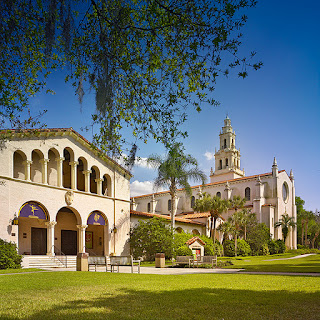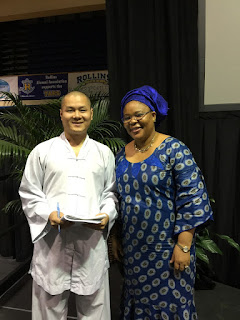An Interview With The Venerable Thich Dong Thanh
Please give some advice to the young Western people, especially the
young Canadians and Americans.
“They should continue their way to
study, to work, to compete, to be creative, to be rich, and to be successful.
In parallel, they should go back to explore their treasure from their religion.
Do not ignore it. At least religion offers ethics and compassion to the life,”
said Thich Dong Thanh.
The Buddhist
meditation retreat in Vancouver, Canada held September 24-27, 2015 is an opportunity
for people in Canada and America to study and practice meditation in order to
enhance well-being and to transform suffering. Six international experts of
meditation are invited to teach, including the Venerable Vien Giac (Vancouver),
Phap Hung (Vancouver), Thong Ly (California), Dong Thanh (Binh Dinh, Vietnam),
Quang Le (Florida), and the main organizer of the event, the abbess of the Phap
Hoa Temple in Vancouver, Minh An. Three hundred practitioners participate in
two languages, Vietnamese and English throughout the retreat. They only eat
vegetarian food.
The Venerable
Vien Giac, the oldest monk in the retreat, opens the retreat with his teaching
on the first day. He reminds the audience that noble silence supports other
retreatants to meditate better. “If you are lazy, you do not have to try to
meditate, yet do not disturb others,” says Vien Giac. “Do not pollute the
universal Dharma.” The Venerable Vien Giac is also a poet and the abbot of Chan
Nguyen Monastery, Vancouver.
Next,
the Venerable Thong Ly teaches the conditions to be born in the Pure Land. In
Buddhism, Pure Land is equal to Heaven in Christianity. “We need to have enough
faith, vow, and action,” he teaches. “Otherwise, your efforts are nonsense.” Ly
studied Buddhism in Taiwan. He now lives
alone in a small and beautiful hut in California. He has annually come to
Vancouver to teach for the past six years.
The Venerable
Phap Hung guides Tai Chi which is the Chinese martial art, a kind of exercise.
Hung had studied meditation in France for nine years since 1999. His meditation
master is Thich Nhat Hanh, the fourth on the list of the most influential one
hundred spiritual leaders in the world, 2015 (1). Hung now lives alone in
Vancouver. “Health is the foundation of practicing meditation,” advises Hung. “If
you are unhealthy, you cannot meditate effectively.”
Quang
Le, the youngest teacher, invites the audience to sing mindful songs. Then he
guides sitting meditation and invite participants to practice for thirty
minutes. He repeats a famous quote of Albert Camus, “Autumn is a second spring
when every leaf is a flower.” Quang reminds, “With colorful Maple’s leaves, the
fall here is miraculous. However, whether we can enjoy the fall, this is a
challenge.” He continues, “we need to
meditate to live in the present moment; we need to enjoy the wonderful moments
that are available in the here and now.” Quang Le has studied meditation in
Vietnam, Thailand, and America for twelve years under the teaching of Thich
Nhat Hanh, too. He now teaches meditation worldwide, especially in America. He
then leads walking meditation across a few roads in the city of Vancouver. They
make one line and walk mindfully and peacefully.
Abbess
Minh An does not teach. She runs the retreat. She announces and reminds the
audience of the schedule of activities. She has organized the retreats yearly.
In this retreat, she is happy to invite the Venerable Thich Dong Thanh, who
received a doctorate in Buddhism at the University of Delhi, India. Thanh is
the president of a Buddhist school in Binh Dinh, Vietnam.
Thanh presents three speeches. The
audience silently and attentively listens to him. Some practitioners agree that
he is the most impressive teacher in this retreat.
“America and Canada are rich,
fresh, and free. Do you want to live here? What is the place that you would
like to live the best?” asks an interviewer.
“I admire America and Canada.
However, I have many interesting things to do in Vietnam. Just staying for a
few weeks is enough,” answers Thanh. “Myanmar is the country I like the best.
It is the Buddhist country. They still preserve the ancient culture. There are
many respected Buddhist masters there, also.”
“The Buddha taught about the Middle Way. In
life, both being so rich or so poor are hard to practice meditation. The
paradox is that Buddhist monastics do not have a salary. Pastors receive a salary,
Rabbis receive a salary, communists receive a salary, everyone receives a salary.
There are two kinds of people who do not receive a salary: Buddhist monastics and
prisoners! In America and Canada, they are so poor compared to the American income
per capita. What do you think about this?” asks the interviewer.
He answers, “Well, in a typical
pagoda, the monastics do not have a salary. The money from donation is
distributed to every member based on their needs for something…”
“Like socialism?” Asks the
interviewer.
“Something like that,” replies
Thanh.
“But it is difficult for the
monastics who live alone in America. They have to spend so much for at least
healthcare and education,” says the interviewer.
“The Buddhist monastics in Japan
receive a salary,” he explains. “I think in developed countries such as Canada
or America, Buddhism needs to adapt and adopt their culture.”
When the retreat ends, many people
cry because of happiness. Many people hug each other. However, the opposing
views are also diverse. A number of practitioners who follow Pure Land method
do not like singing; in their tradition, they are not allowed to sing. In
contrast, some young and Canadian retreat attendants do not like chanting
Amitabha Buddha’s name; they prefer to meditate. “I hate vegetarian food; why
do I have to quit meat?” complains a young girl.
References


















